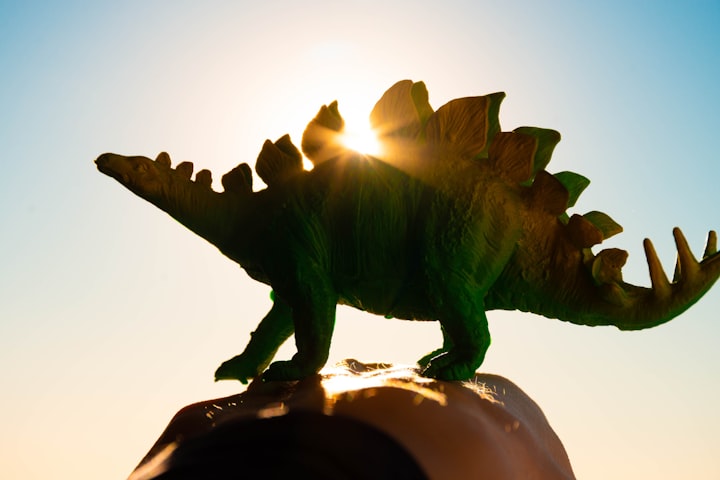There is still a lot that paleontologists don't know about dinosaurs
But based on what is already known, it seems interesting to study and observe these creatures.

1. Bolt ran faster than the Tyrannosaurus rex
Computer simulations of the Tyrannosaurus Rex running show that it has a top speed of about 29 kilometers per hour. While this is not enough to catch a car, it is more than enough to catch most humans.
That is, unless you're an athlete like Usain Bolt, running at 44 kilometers per hour, you won't get caught.
But even Bolt had to run as hard as he could to get away from the emu-like dinosaur (Dromiceiomimus), which had a top speed of 60 kilometers per hour.
2. Some dinosaurs could live up to 300 years
"Paleontologists estimate that large dinosaurs lived between 75 and 300 years. However, these estimates are based on the information we already have for cold-blooded animals, and if dinosaurs had been warm-blooded, they would have lived shorter than that." So writes Laura Mears (Mears).
Most estimates put the longest-lived dinosaurs at least 75 years old and up to three centuries, although the exact age is debated.
Others believe that dinosaurs were thermostats, meaning that their body temperatures could have remained approximately the same.
In addition, some dinosaurs were so large that they would have been "cooked" from the inside if they were warm-blooded, suggesting that they were indeed cold-blooded and had long lifespans.
In contrast, Michael D'Emic, a paleontologist at the State University of New York at Stony Brook, believes that dinosaurs were warm-blooded, just like today's mammals. Some researchers last year argued that dinosaurs were neither cold-blooded nor warm-blooded, but somewhere in the middle of the two. But Demick does not share this view.
He considered the weight and growth rate of dinosaurs derived from fossils and made a judgment about their metabolism to reach this conclusion.
3. dinosaurs have experienced two mass extinctions
Top 10 cold facts about dinosaurs that you should not know
Most people know about the Cretaceous-Tertiary extinction 66 million years ago, when an asteroid struck the Earth and removed more than seventy-five percent of the planet's species.
However, this was not the first mass extinction that dinosaurs experienced. Two hundred and thirty million years ago, dinosaurs also experienced an extinction during the Late Triassic-Jurassic period.
That extinction is thought to have swept away many terrestrial animals, but it also made the massive dinosaurs the dominant force in the prehistoric world.
"There was a mass extinction at the end of the Late Triassic that wiped out many terrestrial animals, providing enough room for the evolution of some of the larger dinosaurs," Mills explains.
4. Some dinosaurs had feathers, but couldn't fly
If you've seen the movie "Jurassic World," you may have noticed that, like "Jurassic Park" before it, velociraptors are depicted as scary, featherless creatures.
But research in recent years has shown that some dinosaurs were covered in feathers - although they apparently couldn't fly.
"Never mind the pictures you see in textbooks and museums, we now know that most dinosaurs were neither scary nor bald." Mills said.
"We already knew that bipedal theropod suborder carnivorous dinosaurs had feathers, but in 2014, a dinosaur found in Siberia also had feathers, suggesting that scales were replaced by feathers very early in dinosaur evolution."
5. Tyrannosaurus rex survived further back than Stegosaurus
Top 10 dinosaur cold knowledge that must not be known
"Although Tyrannosaurus rex and Stegosaurus (Stegosaurus) are often depicted together, it's simply not possible for both dinosaurs to have appeared at the same time and in the same place." Mills said.
"Stegosaurus lived during the Jurassic period, while Tyrannosaurus did not appear until the Cretaceous period, 80 million years later than Stegosaurus."
6. fleas on dinosaurs were ten times the size of modern fleas
Top 10 dinosaur cold knowledge you must not know
If you think modern fleas are scary, think more about the dinosaurs.
Evidence shows that Pseudopulex Jurassic and Pseudopulex giganteus were particularly fond of living on dinosaurs during the Cretaceous period (145 to 66 million years ago) and the Jurassic period (201 to 145 million years ago).
This meant that they had claws long enough to grip dinosaurs and mouthparts that resembled hypodermic syringes.
The largest female flea-like creatures were about 20.6 millimeters long, while the males were 14.7 millimeters long.
"The fossils show that Cretaceous and Jurassic dinosaurs hosted a flea-like insect about ten times the size of today's fleas."
7. the largest dinosaur egg was about 48 cm long
"The largest dinosaur egg was found in Mongolia in the 1990s and was about 45 centimeters wide and 60 centimeters long." Mills said.
"Compared to human size, dinosaur eggs are surprisingly small."
8. Argentinosaurus was longer than a blue whale
The largest dinosaur has always been controversial, but the Argentinosaurus is unquestionably large, weighing 70 tons.
Argentinosaurus lived between 97 million and 94 million years ago and was about 40 meters long and 7.3 meters tall. And the blue whale was only 30 meters long, although it weighed even more amazingly, weighing 200 tons.
In addition, researchers have just concluded that Dreadnoughtus, previously thought to be the largest dinosaur, was not as big as scientists thought it was.
The researchers analyzed a rare fossil discovered by paleontologists in South America in 2014. The huge fossil, found in Patagonia, had nearly all of its major bones intact, allowing scientists to estimate its overall size - which ended up measuring 26 meters long and 40 tons.
9. First documented dinosaur fossil found in 1677
The first scientifically documented dinosaur fossil in history was Megalosaurus, officially named by William Buckland in 1824.
It was discovered in 1677 by Robert Plot, a professor at Oxford University. At the time, he thought it might be the lower limb bone of a dinosaur.
It wasn't until more than a hundred years later that Mr. Buckland became the first person to officially name a dinosaur. Today we know that this carnivorous dinosaur, named Brontosaurus, was 7 meters long and weighed 1.1 tons.
10. Dinosaurs still exist today
"In the 19th century, fossils of a dinosaur called Archaeopteryx were discovered, and since then, there has been increasing evidence of a link between dinosaurs and today's birds," Mills said.
"It is thought that early birds evolved from the carnivorous dinosaurs of the late Jurassic suborder Theropoda, some of which survived the mass extinction and gradually gave rise to the birds we are familiar with today."
But it's not just birds that resemble dinosaurs; the ancestors of modern crocodiles are also thought to have lived in the same era as dinosaurs, and some believe that the two creatures are somehow related as well.
About the Creator
Turnell Feliu
People who shiver from the cold can best appreciate the warmth of the sun. Those who have experienced life's troubles know best the preciousness of life






Comments (1)
Your mind is so active that I can't keep up